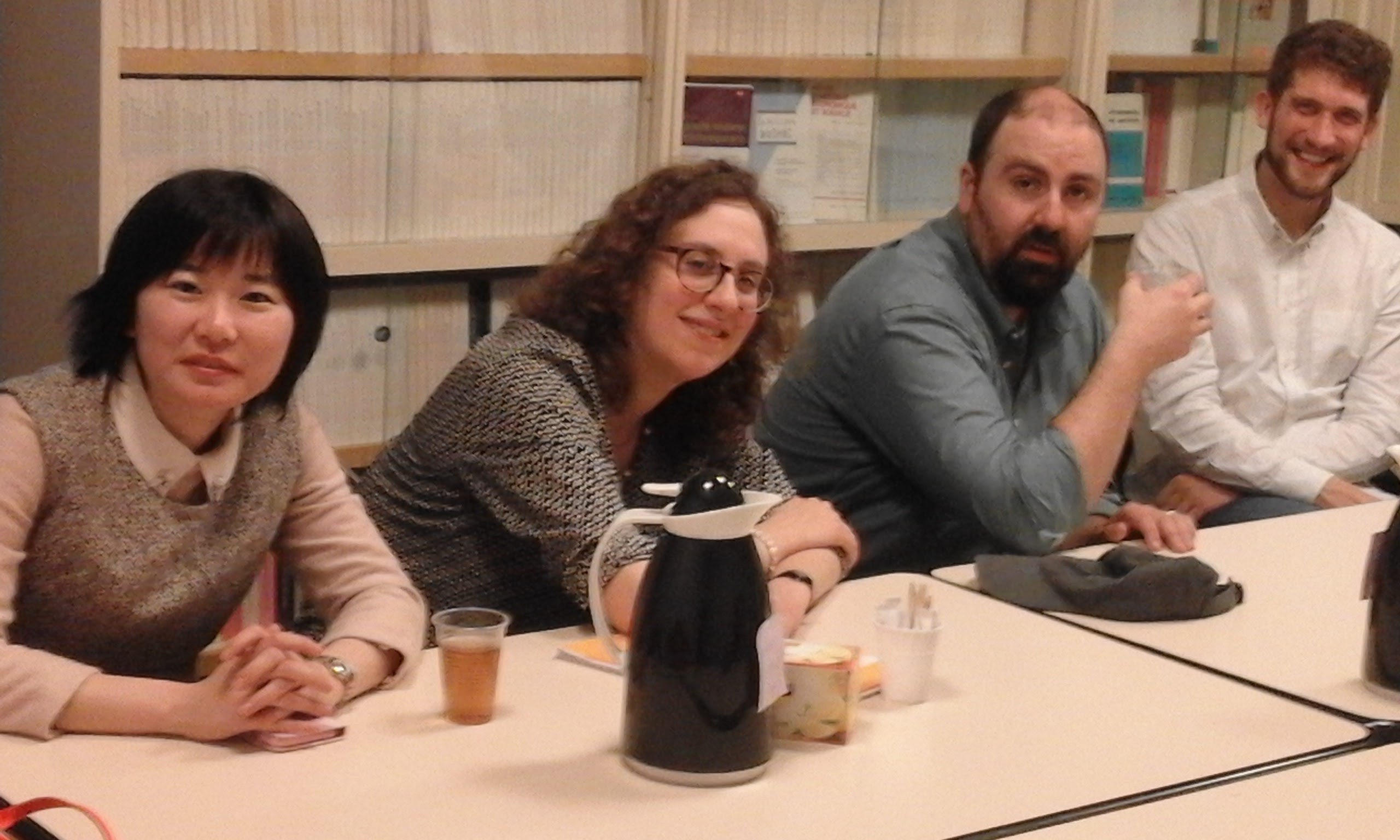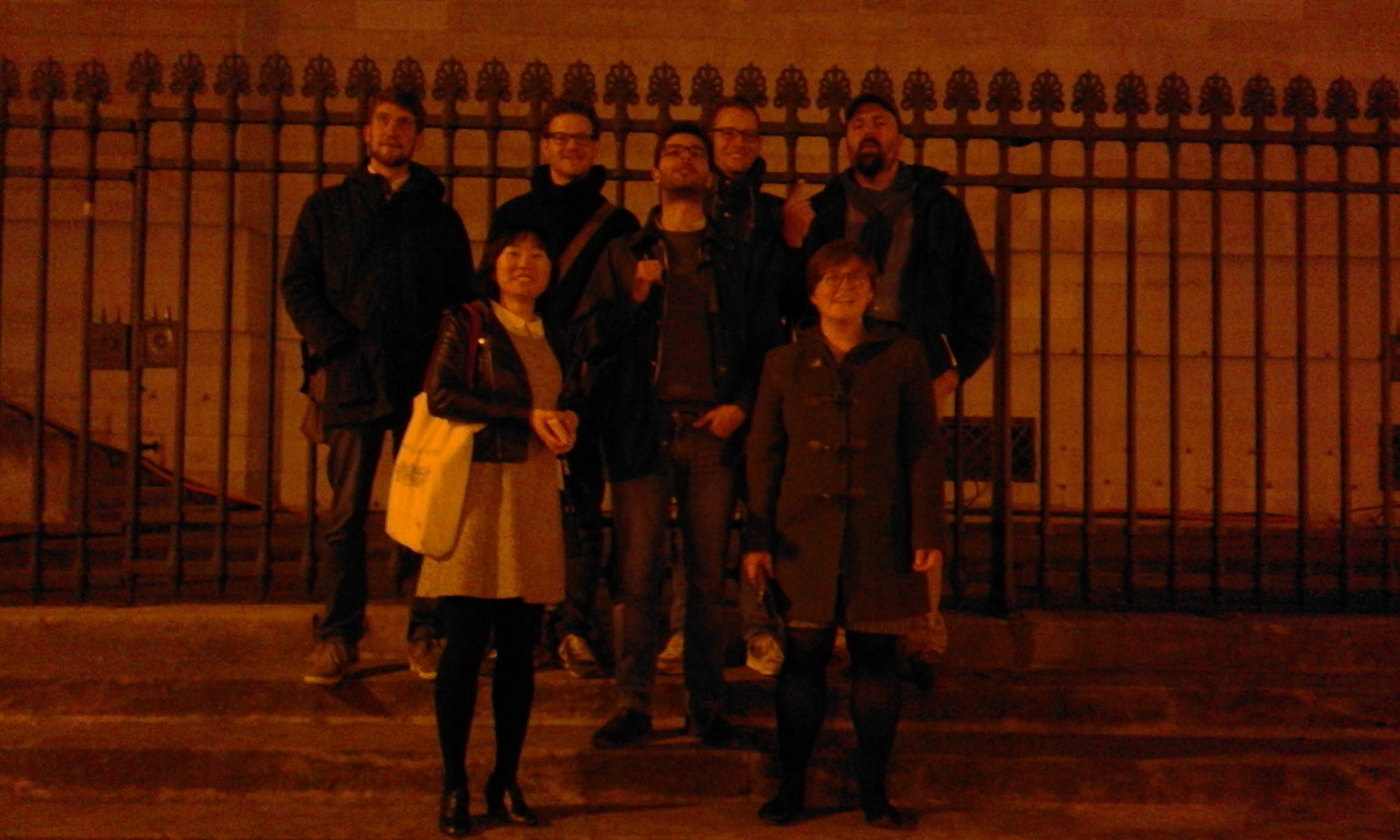2016.04.26
GHC学生ワークショップ Global History Collaborative Students Workshop in Paris(5-7 Apr.2016)
2016年4月5日から7日まで、パリのフランス国立社会科学高等研究院(EHESS)にてGHC学生ワークショップが開催された。
このワークショップ開催の契機は、去年GHC東大拠点で行われた第一回目のサマースクールが終わってから、メンバーたちはそれぞれの研究に基づき、共同執筆の形での『Atelier du Centre de recherches historiques』への投稿提案である。パリで開催されるということで、企画はほとんどEHESSのSarah Abel、Gabriela Goldin Marcovich、Andrea Giorgio Tosatoの三人が担当した。参加者も去年サマースクールに参加したプリンストン大学、EHESS、東京大学、ベルリン自由大学の四拠点の学生たちである。各自の研究分野と関連性により、五つのグループに分け、去年の9月に発案してから、Google hangoutとSkypeなど一連の情報技術を利用して、共同研究を進めた。その成果をドラフトにして、開催前にグループごとに提出した。参加者たちは投稿を意識しながら提出したドラフトを事前に読んだうえで、活発に議論を展開した。
一日目の午前はグループ発表の準備時間であり、グループごとに事前の打ち合わせをした。
午後は、はじめに、EHESSのGabriela Goldin Marcovichによるワークショップ開催までの経緯説明とSilvia Sebastiani 教授による開会の挨拶があった。続いて、三つのグループの発表が行われ、EHESSのSilvia Sebastiani 教授とZuniga Jean-Paul教授がコメンテーターとして出席された。
まず、Fabian Krautwald (Berlin)、Thomas Lindner (Berlin)、Sakiko Nakao (EHESS)は、西アフリカのパン・アフリカ主義者、ラテンアメリカの反帝国主義者、ドイツの植民地主義者をアクターに、「戦っているマージナリティ」(Fighting Marginality)に焦点を当て、1917年〜1919年のグローバル・モーメント及びマージナリティたちの帰属性に関する検討をした。討論内容は、事例研究とグローバル・モーメントとの関係をめぐる研究意義の検討、メキシコ革命という事例の使い方、マージナリティという用語の定義などがある。
そして、Andrew David Edwards (Princeton)、Fabian Steinberg (Berlin)、Andrea Giorgio Tosato(EHESS)は、経済史の面から、「中国のグローバル覇権時代」という題目で、中華帝国による銀の巨大な需要を問題提起し、その後、貨幣システムの変化、イギリスにおける貨幣の本質と外国貿易に関する論争、オスマン帝国の貨幣と統治権をめぐって、早期近代性への解読を試みた。この論文は、今回のワークショップの中で一番協力性が強い論文と言え、中国国内の銀の用途、銀流通のネットワークとヘゲモニーの関係、清朝中国の学者たちの銀流通ネットワークへの認識などについて活発な議論を行った。
続いて、Gabriela Goldin Marcovich (EHESS)、Jiyoon Kim (Tokyo) とMarcia Schenck (Princeton) は対話の形をとり、韓国の海外旅行者及び東ドイツにおけるアンゴラとモザンビークの労働者を例に、グローバル・ヒストリーにおけるグローバル人物に関する研究を発表した。ミクロヒストリーの視点をとり、それぞれの生活史を追いかけることによって、グローバル・ヒストリーとミクロヒストリーの良い接点を見つけた。執筆者であるJiyoon KimとMarcia Schenckはともにプリンストンにいるので、当日Skypeにより、このような斬新な対談の形の可行性、方法論に関する論述と事例分析の比重配置、冷戦のグローバル性、年代順の進み方などをめぐって、ワークショップの参加者たちと討論を重ねた。
二日目の午前に、残りの二つのグループの発表と討論を行い、 EHESSのSilvia Sebastiani 教授、Étienne de la Vaissière教授、Jean Frédéric Schaub教授はコメンテーターとして出席した。
まずは、Mandkhai Lkhagvasuren (Tokyo)とYongchao Cheng (Tokyo)は前近代におけるグローバル・ヒストリーの視角から、13−14世紀のモンゴル帝国と17−18世紀の中日朝三国の「海禁」への再解読を試みた。このグループは一番大きな時間的なスパンと差異性を持っているので、共通的な接点をみつけるために、他の参加者からたくさんの意見と解決策をもらった。協力の仕方については、共同にイントロダクションを書いて、個別に論説を展開していく形で進めることを決めた。東アジアについての検討はより長い時間をとり、昔の時代に溯り、「海禁」の異同点を見つけるなどの提案があった。Mandkhai Lkhagvasurenは東京に滞在しているので、当日Skypeを通じて、参加者たちからモンゴル帝国への解読において、知識というキーワードに絞り、地理範囲を拡大してみるなどの建議をもらった。
次は、Gabriela Goldin Marcovich (EHESS) and Emily Kern (Princeton) は、科学史の角度から、第二次世界大戦中における古生物学の地政学をテーマに、1941年から1946年までの短いスパンをとり、中米両国の古生物者による研究協力のネットワークを解明した。今回のドラフトの執筆は主にEmily Kernが担当したので、Gabriela Goldin Marcovichの協力の仕方と今後の検討の進み方が議論の中心となった。
最後は、円卓会議を行い、グループごとに、この二日間の議論成果のまとめと今後の進み方について交流した。みんなはグローバル・ヒストリーの見方について、ヨーロッパ中心主義への批判の継続、地域研究を越えながら研究の深化を図っている共同研究の進み方、グローバルという言葉は全世界を意味しているわけではないなどの点において一致した。
午後は、グループごとに質問応答の部分でもらった指摘とコメントを整理し、会議記録を作成した。
三日目は『Atelier du Centre de recherches historiques』の編修を担当しているZuniga Jean-Paul教授から投稿の注意事項・格式・日程などの説明を受け、正式的な投稿の準備段階に入る。続いて、特集の名前について、ブレイン・ストーミングでいくつか提案を出して、最終的に投票でExperiments in Global History - a collaborative approachに決まった。
三日間のワークショップは全体で濃密な議論を貫き、各拠点の学生による繋がりを強く感じた。今回の参加者は異なる大学の異なる国の出身者たちなので、共同執筆自体は非常にグローバル性が強いものである。今回の協力は試験として、共同研究のメリットと限界性を見つけるだけでなく、伝統的なグローバル・ヒストリー研究への挑戦の一つでもあると思う。
(文責:程永超)
he Global History Collaborative (GHC) Students Workshop was held from April 5 to 7, 2016, at the School for Advanced Studies in the Social Sciences (EHESS), Paris.
The workshop was undertaken by some graduate students who participated in the First GHC Summer School at Tokyo University in September last year. While attending the summer school, they found a common theme around the topics of global history. Thereafter, they decided to write collaborative articles and put them together as a dossier for the Atelier du Centre de recherches historiques. The workshop was organized by students from EHESS. Students from the GHC hubs at the University of Tokyo, Princeton University, and Freie Universität Berlin, took part in the workshop. Before the workshop, participants used Google Hangout and Skype in order to work together. Before the workshop began, all participants carefully read the draft paper, which had been submitted beforehand, and also prepared comments.
The first morning was for group meetings and preparation. The afternoon session began with opening remarks by Professor Silvia Sebastiani (EHESS) and an introduction to the workshop by Gabriela Goldin Marcovich (EHESS). Then three groups gave their presentations. Professor Silvia Sebastiani and Professor Zuniga Jean-Paul (EHESS) acted as commentators.
The first presentation was by Fabian Krautwald (Berlin), Thomas Lindner (Berlin), and Sakiko Nakao (EHESS) on the topic of Fighting Marginality. They used case studies of West African Pan-Africanists, Latin American anti-imperialists, and German colonialists, to discuss the Global Moment of 1917-19 and the Re-Imagination of Belonging. Questions from the floor were primarily centered on the relation between case studies and global moment, treating the Mexican Revolution as a secondary issue and the definition of marginal.
The next presentation, by Andrew David Edwards (Princeton), Fabian Steinberg (Berlin), and Andrea Giorgio Tosato (EHESS), was entitled “Reinterpreting Early Modernity: The Era of Chinese Global Hegemony.” The huge demand in China for silver in the early modern period was addressed in the first chapter. After a discussion on the debate over the nature of money and foreign trade in England, Steuart and the Bengal Democide, and Ottoman Money and Sovereignty, the speakers presented global history from the monetary perspective in the last chapter. There were questions on how China used the large amounts of silver, the relationship between the silver circulation network and hegemony, as well as recognition of the silver trade network by scholars in Qing China.
This was followed by a video presentation by Jiyoon Kim (Tokyo) and Marcia Schenck (Princeton). They took the novel conversation form to discuss global lives in global history, employing the cases of South Korean overseas travelers and Angolan and Mozambican laborers in East Germany during the Cold War. By asking questions about the study of “global mobile lives” in the form of collective biography, life history, and travel writing, they contributed to world history from a microhistorical perspective, which might be called “global microhistory.” The general discussion and suggestions were focused on questions about the feasibility of this dialogue style, the proportion of methodology and wiring, directly tackling common themes such as global cold war and the chronological problem.
On the second day, the ideas of two groups were discussed. Professor Silvia Sebastiani, Professor Étienne de la Vaissièr and Professor Jean Frédéric Schaub attended the morning session.
Mandkhai Lkhagvasuren (Tokyo) and Yongchao Cheng (Tokyo) gave a presentation on how to interpret the history of East Asia from the 13th century to the 18th century from the perspective of global history. This duo struggled to agree on a topic that would enable contribution from both participants. The disagreement stemmed from the duo’s different geographical and periodical specializations. Although some possible common grounds were suggested, writing separate papers with a common framework or introduction was thought to be more advisable. For Mandkhai, reinterpreting the 13th and 14th centuries from the connections and entanglements, which resonate with the global history approach, is a good direction. It was suggested that Yongchao continue re-deciphering resistance/negativity from a global historical perspective. The professors also pointed out future problems such as stepping out of the time frame of the papers in different ways in terms of geography as well as time frame.
Gabriela Goldin Marcovich (EHESS) and Emily Kern (Princeton) gave the last presentation, entitled “The Geopolitics of Paleontology in Wartime: Global History on the Small Scale, 1941-1946”. This draft explored the disruption and reconstitution of systems of international exchange in East Asian human paleontology during the massive geopolitical disjuncture during World War II. Since this draft was mainly written by Emily, the discussion focused on how could Gabriela be a co-author as well as further development of the idea.
This was followed by a roundtable on presentations. Participants summarized discussion points and possible future directions. They reached a consensus on continuing the criticism of Eurocentrism, joint research that needs to deepen the discussion as well as go beyond area studies, and the word “global,” which does not mean the whole world. In the afternoon, they collated notes from the workshop and drew up the minutes of each session.
On the third day, Zuniga Jean-Paul, the editor of Atelier du Centre de recherches historiques, gave a speech on the layout, procedures and schedule of article submission. Participants then presented several proposals on the name of the dossier. “Experiments in Global History-a collaborative approach” was decided upon by a final vote.
The three-day workshop was marked by intense discussion, giving a clear impression that the graduate students from the four GHC hubs had forged a connection. Given that the participants are from different universities and different cultural backgrounds, the co-authoring itself is a global phenomenon. The collaborative workshop was an experimental endeavor, which not only helped us discover the advantages and limitations of joint research, but one that will also be a challenge to the traditional global history research method.
(CHENG Yongchao)















